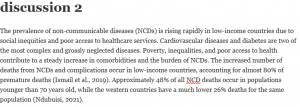discussion 2

The prevalence of non-communicable diseases (NCDs) is rising rapidly in low-income countries due to social inequities and poor access to healthcare services. Cardiovascular diseases and diabetes are two of the most complex and grossly neglected diseases. Poverty, inequalities, and poor access to health contribute to a steady increase in comorbidities and the burden of NCDs. The increased number of deaths from NCDs and complications occur in low-income countries, accounting for almost 80% of premature deaths (Ismail et al., 2019). Approximately 48% of all NCD deaths occur in populations younger than 70 years old, while the western countries have a much lower 26% deaths for the same population (Ndubuisi, 2021).
NCD infections drain the economic resources of a country due to its high healthcare cost in managing the diseases when they occur, considering their chronic nature and complications. Countries with poor resources and inefficient health systems are unprepared for the severe burden of diabetes and complex cardiovascular diseases, mainly because the complications are multifaceted, chronic, debilitating, and costly (Bollyky et al., 2017). With limited funds in developing countries, it is essential to stress education and preventive strategies for diabetes and cardiovascular disease control to reduce the government’s economic burden. Preventing cardiovascular and diabetes saves healthcare costs and improves the quality and longevity of life (Holtz, 2017). Furthermore, contributing factors such as poverty, unhealthy diets, unemployment, and poor access to health services lead to more comorbidities. Failure to allocate funds to preventive care initiatives can result in premature death, disabilities, and an expensive disease burden (Bollyky et al., 2017).
These preventive strategies may include tobacco cessation, nutritional education, and obesity control. Furthermore, with limited funds, healthcare professionals can educate the public on preventive strategies to help prevent diabetes and cardiovascular diseases.
Tobacco use Cessation
Tobacco use was low in developing countries compared to developed countries. However, there is an increased rate of tobacco use among low- middle-income countries (Holtz, 2017). Tobacco cessation programs and advertisements can be shown on public media such as television and radio to encourage tobacco cessation and prevent risks and complications from further use. Tobacco cessation information should create an awareness of the adverse effects of its use. Tobacco cessation education must be done in all local languages for easy understanding.
Nutrition and Obesity Control
Nutritional education to reduce high fat and caloric diet prevent excessive weight gain and reduce insulin resistance. However, the challenge is the inability of some people in developing countries to afford food and eat anything that can be afforded, whether high fat or high caloric. Therefore, education in the use of salt and sugar sparingly must be encouraged, including daily adequate water intake. In addition, a simple as brisk walking for 30 minutes daily helps prevent excessive weight gain and improves well-being.
Working toward preventing diabetes and cardiac disease by educating the population on lifestyle changes and offering community-based services is highly beneficial for the health and well-being of people in low-income countries